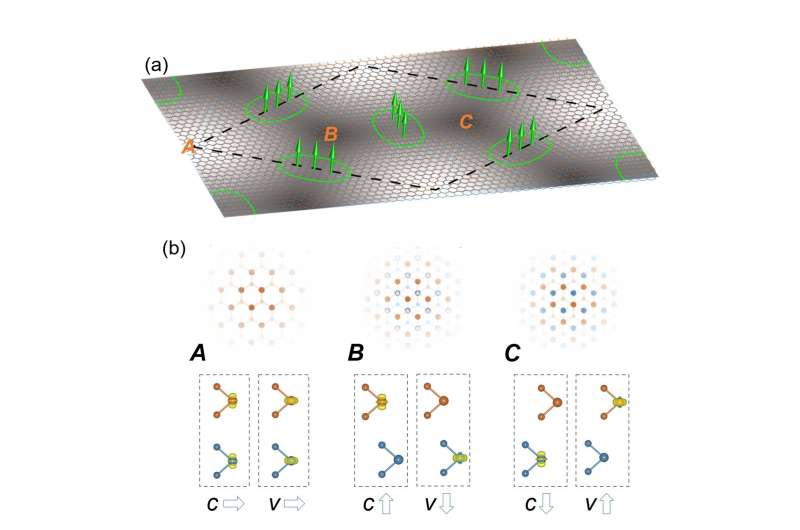Realizing a giant magnetic field by moiré pattern engineering

Scientists at the University of Hong Kong and Hunan Normal University showed that, in homobilayer transition metal dichalcogenides, the real-space Berry phase from moiré patterns manifests as a periodic magnetic field. The field magnitude can reach hundreds of Tesla for a typical moiré period of 10 nanometers. For low energy carriers, this Berry phase induced magnetic field realizes a topological flux lattice for the quantum spin Hall effect.
In van der Waals layered structures, when two adjacent layers have small lattice mismatch and nearly aligned crystalline directions, the interlayer atomic registry will vary periodically on a length scale much larger than the monolayer lattice constant, known as the moiré superlattice. Engineering of the moiré pattern has become a powerful approach for tailoring electronic, optical and topological properties.
The nature of the moiré pattern as a spatial texture of atomic configurations suggests that the real-space Berry phase effect can be an indispensable part of moiré superlattice physics. In condensed matter materials, the internal quantum structure (spin or pseudospin) of a quasiparticle can have a dependence on its position and momentum, which can give rise to the real-space and momentum-space Berry phase effects. Some well-known manifestations of the momentum-space Berry phase are the anomalous Hall and spin Hall effects in homogeneous crystals. Meanwhile, spatial inhomogeneity can give rise to the real-space Berry phase which is the total flux of the Berry curvature through a surface enclosed by a loop. The real-space Berry curvature acts as a magnetic field, which can also lead to Hall current. Such topological Hall effects have attracted remarkable interest, and have been observed in magnetization skyrmion and domain structures.
Recently, in a research article published in National Science Review, scientists at the University of Hong Kong, Hong Kong, China, and at the Hunan Normal University in Hunan, China present the possibility of realizing giant magnetic field by moiré pattern engineering. Co-authors Hongyi Yu, Mingxing Chen and Wang Yao showed that, in homobilayer transition metal dichalcogenides, the real-space Berry phase from moiré patterns manifests as a periodic magnetic field, with the magnetic flux per moiré supercell being a quantized value. In a moiré pattern introduced by a uniaxial strain, the magnetic flux has a different sign from that introduced by a twisting or biaxial strain, although they can have the same potential landscape. The field magnitude scales inversely with the square of the moiré period, and can reach hundreds of Tesla for a typical moiré period of 10 nanometers. Remarkably, the real-space profile of the moiré magnetic field can be continuously tuned by an interlayer electric bias. Under a modest electric bias, a topological transition occurs where the magnetic flux per supercell has a quantized jump (from ±2π to 0).
More information: Hongyi Yu et al, Giant magnetic field from moiré induced Berry phase in homobilayer semiconductors, National Science Review (2019). DOI: 10.1093/nsr/nwz117
Provided by Science China Press




















